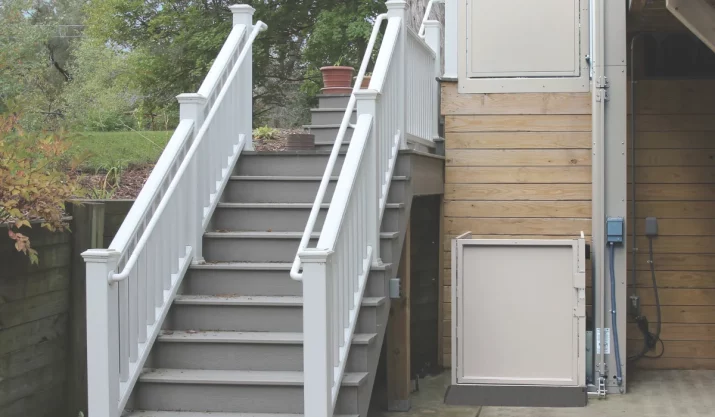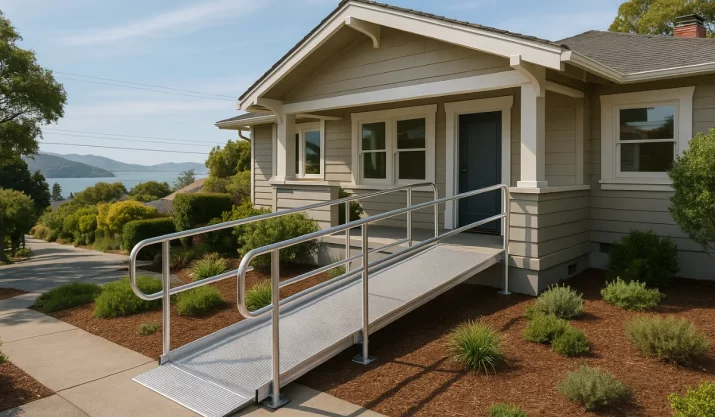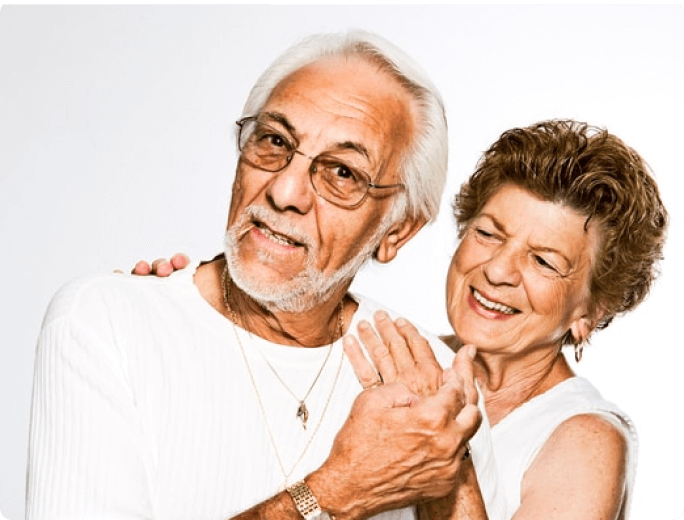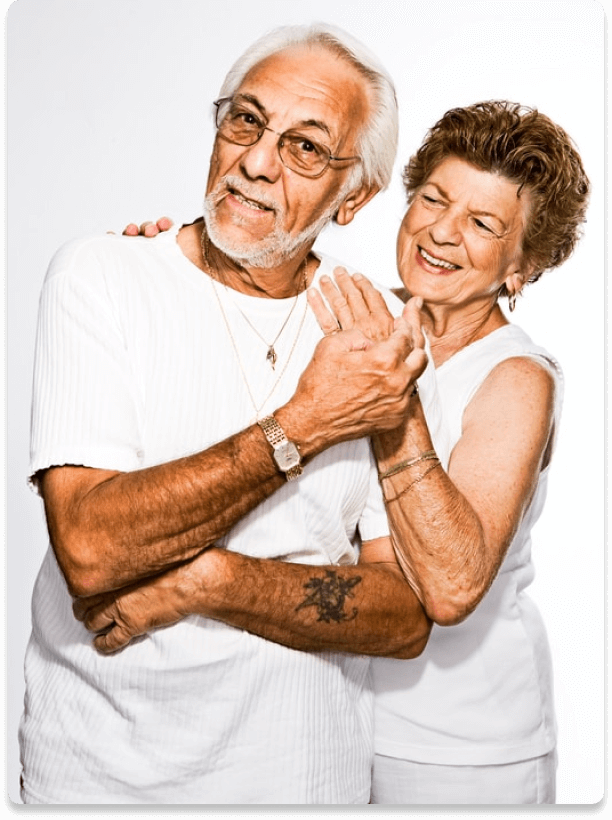Are Vertical Platform Lifts Safe for Children and Pets?
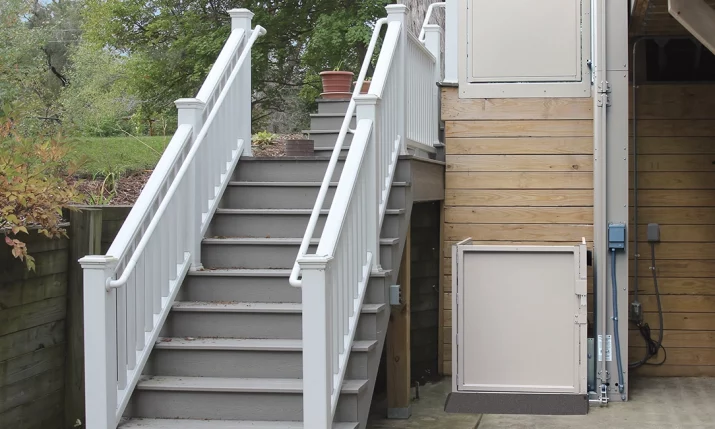
Table of Contents
- Key Takeaways:
- What is a vertical platform lift?
- Are vertical platform lifts safe for kids and pets?
- Built-in safety features you should know about
- Additional safety tips for families
- Are outdoor VPLs safe?
- How do vertical platform lifts work?
- VPL vs. stair lift: Which is safer for households with children and pets?
- Why professional installation matters
- Conclusion: VPLs are a wise, family-safe choice
- FAQs
Vertical platform lifts (VPLs) are becoming a standard accessibility solution in homes and buildings across California. They help people with limited mobility, especially wheelchair and scooter users, move between different levels with ease. But if you have kids or pets at home, you might be wondering: are vertical platform lifts safe for them?
This guide walks through the essential safety features, functionality, and setup tips to help you protect your whole household.
Key Takeaways:
- VPLs include key safety features such as interlocks, enclosures, non-skid platforms, and emergency stop buttons, to help protect children and pets.
- Professional installation ensures the lift is secured correctly, level, and compliant with California building codes and ASME safety standards.
- Children and pets should never use the lift without supervision. Lockable control panels and active monitoring help prevent accidental use.
- When properly maintained, outdoor VPLs are weather-resistant and safe for family homes, providing a secure way to move between levels.
What is a vertical platform lift?
A vertical platform lift, or VPL, is a powered device that transports a person and their mobility device straight up and down between two points, like a garage and first floor, or a porch and entryway. VPLs are often installed in a hoistway or used in open areas with gates and barriers.
They differ from inclined platform lifts, which travel along the angle of a staircase. Both types of lifts work to improve access, but VPLs offer vertical lifting without requiring you to transfer out of your mobility aid.
Are vertical platform lifts safe for kids and pets?
Yes. VPLs are designed with safety in mind, for both users and bystanders. When installed by a certified technician and maintained regularly, a vertical platform lift can be a cost-effective and family-safe accessibility solution.
All VPLs must follow ASME A18.1 safety standards and local California building codes. Many models are also ADA-compliant, especially in commercial settings. These standards help ensure that the functionality of the lift is secure, reliable, and built for safe everyday use.
In the sections below, we’ll explore VPL safety features that keep children and pets protected.
Built-in safety features you should know about
1. Enclosures and gates
Most residential VPLs feature an enclosure or platform gate to prevent falls from height. A hoistway can fully enclose a VPL, providing more protection. This safety feature is beneficial at the top landing, where there’s a higher risk of children or pets getting onto the platform alone.
2. Interlock systems
An interlock prevents the lift from operating unless all gates and doors are closed. This interlocking system makes it nearly impossible for someone to activate the lift while another person or pet is near the platform area.
3. Emergency stop buttons
Every VPL includes marked emergency stop buttons that allow the user, or a nearby adult, to halt the lift instantly. These safety features are helpful if a child or pet unexpectedly enters the lift area.
4. Non-skid surfaces and level boarding
VPL platforms have textured, non-skid floors for stability. They stop flush with the floor level to allow safe, barrier-free entry and exit. This design reduces tripping hazards for young kids or smaller pets.
5. Controlled speed and smooth stops
To prevent sudden jerks or tipping of mobility devices, VPLs offer soft starts and stops. This feature helps maintain balance for riders and reduces anxiety for pet owners with curious animals nearby.
Additional safety tips for families
Even with all these built-in protections, the way you use your lift matters. These tips can further improve safety in homes with children or pets:
Supervise young users
Children should never operate the lift alone. If your child uses a wheelchair, help them in and out, and supervise the ride, especially during transitions at the lifting height.
Use locking controls
Many models feature lockable key switches or digital PIN pads on the control panel. This security feature prevents children from pushing buttons when you’re not looking.
Block off the area
Create a safe zone using baby gates or furniture so children and pets can’t access the platform when it’s not in use.
Schedule regular maintenance
Have a technician inspect your lift every year to ensure all components, from the hoistway structure to the top landing gate, are functioning correctly and meet current safety codes.
Are outdoor VPLs safe?
Yes. VPLs can withstand rain, wind, and California’s coastal climate. Look for the following features when choosing an outdoor VPL:
- Weather-sealed control panels
- Rust-resistant materials
- Covered enclosures or integrated hoistways
Just like indoor models, outdoor VPLs are safest when a professional installs them. They should meet local building codes for lifting height, travel distance, and emergency power options.
How do vertical platform lifts work?
VPLs use hydraulic or screw-drive systems to move the platform between levels. They keep the platform level throughout the ride, no matter the distance or weight. The platform rises vertically and stops precisely at the desired floor, allowing smooth transitions without needing to transfer from a mobility device.
Lifts typically include:
- A platform with a non-slip surface
- Guard panels or an enclosed hoistway
- A control panel with up/down buttons
- Safety gates at the bottom and top landing
Whether you’re riding or assisting someone, these lifts work reliably across various indoor and outdoor setups.
VPL vs. stair lift: Which is safer for households with children and pets?
While both lift types are safe when used properly, VPLs with enclosures or hoistways provide better containment, especially helpful if you have a busy household.
| Feature | Vertical Platform Lift | Stair Lift |
|---|---|---|
| Travel direction | Vertical | Inclined |
| Enclosed option | Yes (hoistway or gate system) | Rare |
| Wheelchair accessible | Yes | No |
| Safety at top/bottom | Gate or interlock at each end | An open seat may be exposed |
| Child/pet supervision | Easier to monitor | Children can more easily climb on |
Why professional installation matters
A vertical platform lift is a powerful piece of equipment. To operate safely, it must be:
- Installed per local building codes
- Anchored correctly to handle the lift’s weight capacity
- Positioned to stop flush with the floor level at each landing
- Set to meet your required lifting height and travel range
A licensed installer will also test emergency features, verify the control panel functionality, and ensure all safety interlocks engage properly.
Conclusion: VPLs are a wise, family-safe choice
With the right features and proper setup, vertical platform lifts are a safe, cost-effective way to improve home accessibility even in households with pets and children. Their thoughtful functionality, built-in protections, and adaptability across indoor and outdoor settings make them an ideal choice for California families.
If you’re considering a lift for your home, focus on models with complete enclosures, reliable interlocks, and safety-rated components. Always work with a professional installer to make sure your lift meets both your needs and local code requirements.
At California Mobility, your safety is our priority. We’ll make sure your VPL installation meets your needs and local code requirements.
Contact us today or request a free quote and learn more about VPL options that fit your family’s needs.




